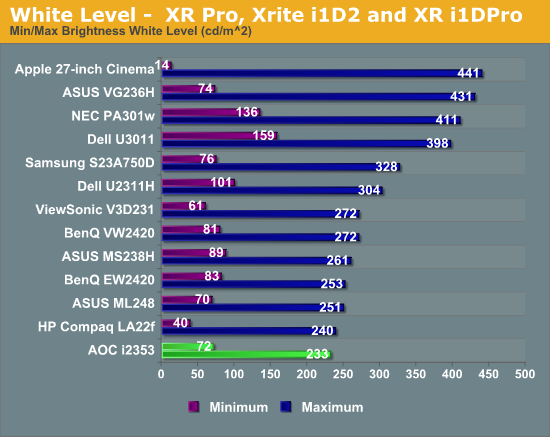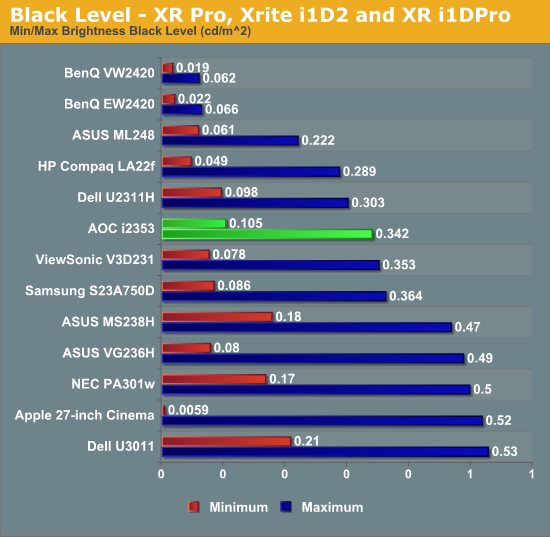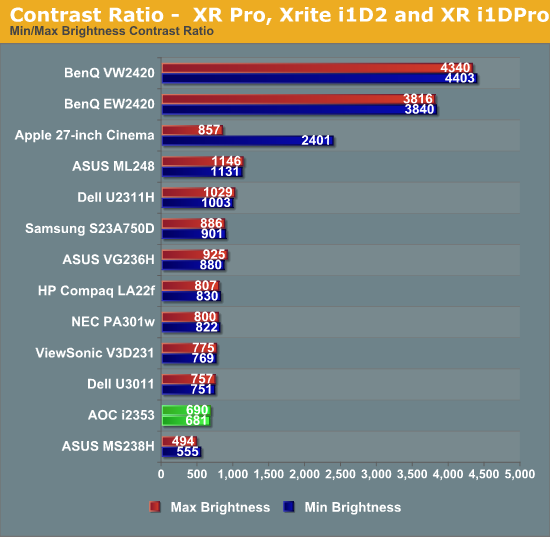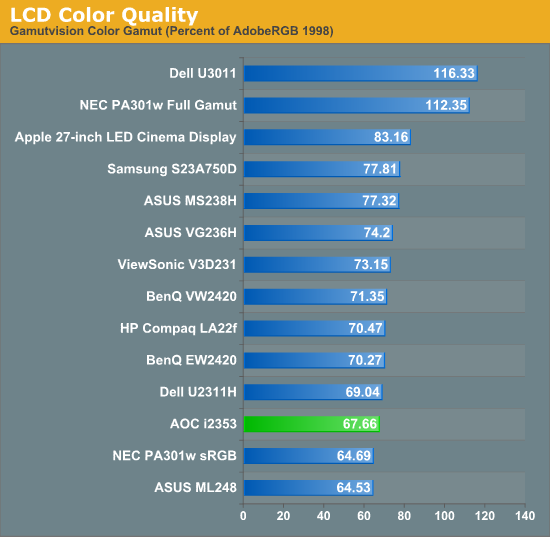AOC i2353Ph - IPS for a nice, low price
by Chris Heinonen on January 30, 2012 12:40 AM ESTPeak Levels, Contrast, and Color Gamut
The brightness uniformity of the AOC was overall good, but just how bright can the AOC go? With it set to user mode, and the backlight raised all the way up, I only managed to get 233 nits out of the display with a solid white screen. Since it is a matte surface and not glossy, reflections should not be a big issue and this level of light should be more than enough for most people. Unless you have direct sunlight on your display I don’t think most people would need more light output than it provides.
Turning the backlight all the way down left us with 72 nits of light output, which lets us know we can turn the display down enough for print work, or a completely dark environment, without having an image that is too bright for what we are working on.

After the black uniformity tests, I was a little bit worried about what the minimum black levels would be, and it looks like I was correct on that. With the backlight set to maximum, and pure black screen gave us 0.342 nits of light, which is pretty bright for a black screen. Lowering the backlight all the way down to minimum took the black level down to 0.105 nits, which is still high. This is similar to the last eIPS display that came past my desk (The Dell U2311H), and we discussed that black levels are an area that IPS still needs to work on. For comparison, the recent VA panels from BenQ with an LED backlight have a black level at maximum brightness, 0.066 nits, that is still far lower than the AOC can put out with the backlight level at minimum. If deep, rich black is important to you, you probably will want to look at an option other than the AOC, or even IPS altogether.

Once I saw the black levels, I had a feeling that the contrast levels were going to leave something to be desired. Looking at what the AOC can produce, we can’t quite hit 700:1 for the contrast ratio with the backlight at high or low power. This isn’t really surprising given the price point of the AOC, and the use of an IPS panel.

As we discussed in the calibrated results section, the color gamut on the AOC is a bit smaller than the sRGB colorspace. When we measure against the AdobeRGB colorspace, we expect to see a monitor be able to reproduce around 71% of that if it is sRGB capable, but with the AOC we only saw 67.7% coverage. This is what is leading to the larger average dE error, as it can’t produce some of the colors we are looking for, but it still has a lower median dE since it does a good job with the colors it can produce.











71 Comments
View All Comments
VoraciousGorak - Monday, January 30, 2012 - link
My 6ms Dell 2407WFP has not only been perfectly adequate for games of any kind, I've never noticed it ghost. Ever. And I'm sensitive enough to monitor weirdness that SLI microstutter pisses me off.james.jwb - Monday, January 30, 2012 - link
I had one of these and I noticed some ghosting, but the main problem with them was input lag. You really want a screen with no more than 15ms input lag to be rid of issues. If you put a u2412m side by side with a 2407 and duplicate the desktop, you'd notice it simply by moving the mouse.The old S-PVA screens never really got input lag down to acceptable levels.
JarredWalton - Monday, January 30, 2012 - link
I've still got a 2408WFP sitting around my place, and I can definitely agree that processing lag is too high. Even my wife -- a non-techie user -- noticed it when I recently switched her to that display from an IPS panel. She thought the problem was the mouse, so I switched mice and the problem was still there. If you only ever use an S-PVA display, you may not notice what you're missing, but once you have a better reference point it becomes immediately clear that there are delays on the S-PVA panels. That said, I've never had issues with the <20ms lag; it's only when you start getting above that where it becomes noticeable (for me).JonnyDough - Monday, January 30, 2012 - link
Agreed. Input lag is also a problem. Many gamers don't seem to notice these things, but I certainly do. Maybe we were just spoiled with CRT monitors from back in the day?Sabresiberian - Monday, January 30, 2012 - link
He did.The fact is, most people wouldn't be effected by this much lag, even in FPS gaming.
That being said, if you don't pay attention to the lag from each component of your system it could all add up to something that does effect your performance, so getting a monitor with lower lag can be a plus. However, if you really want lower lag in gaming, I suggest a CRT. Of course if you demand larger than 21" you can't really do that, but then I suggest gaming lag isn't your main concern, if that's the case.
(You also pretty much have to buy used, since they aren't made anymore. However, you can find CRT monitors with better quality than LCDs for less money.)
;)
Zingam - Tuesday, January 31, 2012 - link
TN monitors are crap! I have one low end IPS display and I love it. It is perfect even for games! Oh, yeah, and I connect it to a laptop with ordinary TN display and do you know what? I hate looking at the laptop because of its crappy TN display!TN sucks! That's it! Get over it, losers!
MadAd - Wednesday, February 1, 2012 - link
Im waiting to replace my current IPS, but I wont take TN either.Why no display port too? Or 1200 lines? I want something to drop in the middle of my other 2 24" displays, so i can drive them in a big desktop, having one at 1080 is going to mess it all up.
Seems ill be waiting a long time.
eezip - Monday, January 30, 2012 - link
In the last row of the table on page 1, should the price check be 1/24/2012, instead of 2011?cheinonen - Monday, January 30, 2012 - link
Sorry, fixed!demonbug - Monday, January 30, 2012 - link
On the power use chart, do the Apple Cinema Display and Dell U3011 really use more power at min. brightness than at max, or did they just get their numbers reversed?